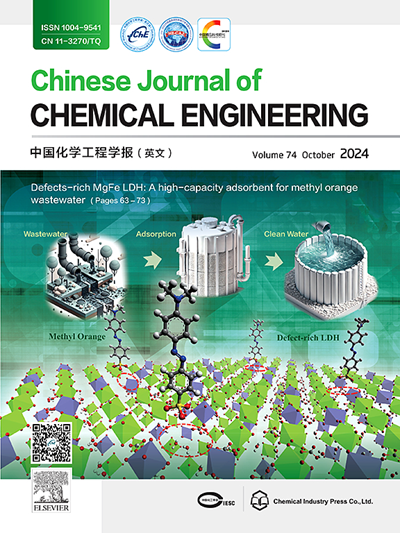Alkylation of benzene and 1-dodecene over cerium-silicate pillared MWW zeolite
IF 3.7
3区 工程技术
Q2 ENGINEERING, CHEMICAL
引用次数: 0
Abstract
The cerium-silicate pillared MWW zeolites are fabricated by introducing Ce species into the silica pillars within adjacent MWW layers through a liquid-phase pillaring method, and the multiple-layer structure of MWW zeolites is well maintained. However, it's found that these Ce3+ species can produce the Brønsted acid sites by the dissociation of water molecules owing to the electrostatic field of Ce3+ cations, the splitting of water molecules occurs following [Ce(H2O)n]3+n ⇌ Ce[(OH)(H2O)n–1]2+ + H+ equation based on the Plank-Hirschler mechanism, leading to superior activity of resultant cerium-silicate pillared MWW zeolites in the alkylation between benzene with 1-dodecene. Moreover, the additional Ce species located in the silica pillars can be easily accessed by guest molecules due to the presence of mesopores between neighboring MWW layers, which can strongly active benzene molecules by polarization effect, and dodecyl carbenium ions are preferred to attack the carbon atoms located in activated benzene molecules, resulting in the long lifetime of cerium-silicate pillared MWW zeolites since the oligomerization of long-chain olefins is suppressed. Under harsh reaction conditions (benzene/1-dodecene = 10, WHSV = 20 h−1), the optimized cerium-silicate pillared MWW zeolite shows outstanding activity (>40%) and excellent selectivity (>85%) of 2-LAB in the alkylation of benzene with 1-dodecene.

求助全文
约1分钟内获得全文
求助全文
来源期刊

Chinese Journal of Chemical Engineering
工程技术-工程:化工
CiteScore
6.60
自引率
5.30%
发文量
4309
审稿时长
31 days
期刊介绍:
The Chinese Journal of Chemical Engineering (Monthly, started in 1982) is the official journal of the Chemical Industry and Engineering Society of China and published by the Chemical Industry Press Co. Ltd. The aim of the journal is to develop the international exchange of scientific and technical information in the field of chemical engineering. It publishes original research papers that cover the major advancements and achievements in chemical engineering in China as well as some articles from overseas contributors.
The topics of journal include chemical engineering, chemical technology, biochemical engineering, energy and environmental engineering and other relevant fields. Papers are published on the basis of their relevance to theoretical research, practical application or potential uses in the industry as Research Papers, Communications, Reviews and Perspectives. Prominent domestic and overseas chemical experts and scholars have been invited to form an International Advisory Board and the Editorial Committee. It enjoys recognition among Chinese academia and industry as a reliable source of information of what is going on in chemical engineering research, both domestic and abroad.
 求助内容:
求助内容: 应助结果提醒方式:
应助结果提醒方式:


